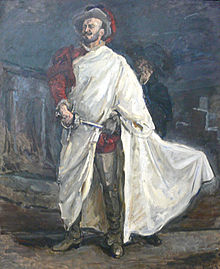Literature / Writers Datebook: November 13
Brief biography of Scottish novelist, short-story
writer and essayist, R.L. Stevenson, famous for classic novels Treasure Island,
Kidnapped and The Strange Case of Dr. Jekyll and Mr. Hyde.
Robert Louis Stevenson was a leading advocate of neo-romanticism in English literature.
Early Life of Robert Louis Stevenson
Robert Louis Balfour Stevenson was born on
November 13, 1850, at Edinburgh, Scotland. A very sickly child, he suffered from poor health all his life. His father, Thomas Stevenson, and his grandfather, Robert Stevenson, were distinguished lighthouse engineers and designers, and so was his great-grandfather. From this side of the family, R.L. Stevenson inherited his passions for adventure.
From Margaret Balfour, his mother, he inherited weak lungs that kept him constantly bedridden during winter. His nurse spent long hours reading from the Bible. His maternal grandfather, Lewis Balfour, was a professor of moral philosophy and a minister. Stevenson spent the greater part of his boyhood holidays in his house.
Summer was a brighter season as he was encouraged to play outside. At the age of 11, his health improved that his parents
prepared him for education by attending Edinburgh Academy, planning for him to follow his father as a lighthouse engineer. He read widely during this time, especially enjoying Shakespeare, Walter Scott and John Bunyan.
He entered the University of Edinburgh at 17, but soon discovered that he was not interested to be an engineer and was more excited with exotic and wonderful romances in the islands and coasts they visited. His strict father eventually allowed him to pursue a literary career, but first finished a law degree as a fall back. He passed the bar examination
at 25, but destroyed his health from work-stress. He turned to serious writing.
R.L. Stevenson Writing Career and Marriage
His first book, An Inland Voyage, is about his river trip in France. It was published
when he was 28 years old. About this time, he met Fanny Van de Grift, an American who was studying art in Paris. They married in 1880 and returned to Scotland with his new wife and stepson.
Stevenson became a famous writer after he published his famous novel, Treasure Island, an adventure story set among pirates. This made a popular writer, aged 33. Another classic, Kidnapped, followed, a tale based on a true Scottish murder case. After these two masterpieces, he wrote several more adventure stories before producing another famous book, The Strange Case of Dr. Jekyll and Mr. Hyde. He was 36.
Last Years of R.L. Stevenson
From all his travels, Stevenson returned to the U.S. in 1886 but due to ill-health, he was hospitalized. Once he got well, he set off with his family on a four-year voyage around the South Pacific. The family settled on the island of Samoa, where he continued writing.
During the morning of December 3, 1894, while working on his last novel, Weir of Hermiston, and conversing with his wife, he fell to the ground. He died within a few hours, probably of a cerebral hemorrhage. This book was left unfinished.
The natives called him their Tusitala,
Samoan language for "Teller of Tales." He was buried on top of a
cliff overlooking the sea. He died at the age of 44, December 3, 1894. Robert
Louis Stevenson was greatly admired by many authors including Ernest Hemingway,
Rudyard Kipling, Vladimir Nabokov.
Books by Robert Louis Stevenson
An Inland Voyage, 1878
Travels with a Donkey in the Cevennes, 1879
Treasure Island, 1883
A Child’s Garden of Verses, 1885
Kidnapped, 1886
The Strange Case of Dr. Jekyll and Mr. Hyde,
1886
The Master of Ballantrae, 1889
Weir of Hermiston, 1896 (Published after death)
Image Credit:
Robert Louis Stevenson. Public Domain
Resources:
Goring, Rosemary, Ed. Larousse Dictionary of
Writers. New York:
Larousse, 1994
McGovern, Una, Ed. Chambers Biographical
Dictionary. Edinburgh:
Chambers Harrap Publishers, 2002
Ousby, Ian.
The Cambridge
Guide to Literature in English. Cambridge: Cambridge University Press, 1993.
(c) November 2013. Tel. Inspired Pen Web. All rights reserved.


















